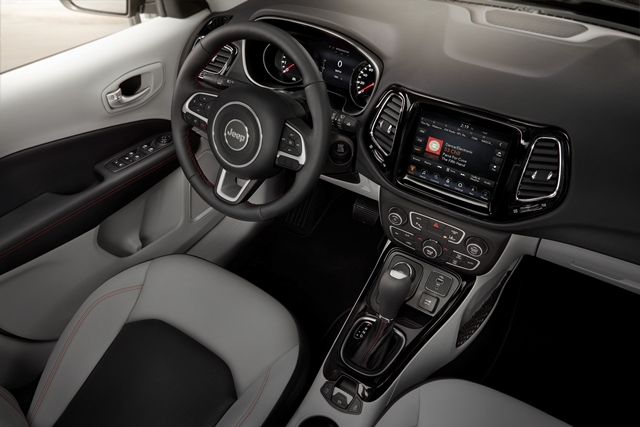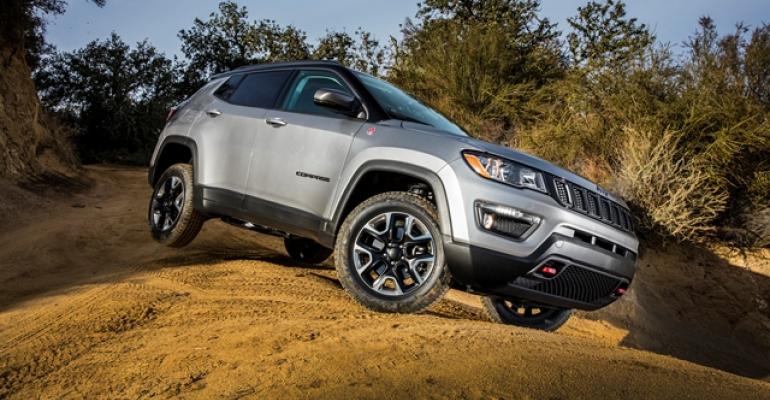SAN ANTONIO – The small Jeep FCA’s predecessor Chrysler should have designed, engineered and built a decade or more ago arrives in the form of the all-new Compass, a miniaturized version of the beloved Grand Cherokee.
FCA’s first truly global Jeep, the Compass already is setting sales records in Brazil, where it was introduced late last year, and the Italian-American automaker expects nothing less when the CUV gets traction in the North American market by midyear. The new Compass also goes on sale in Europe, the Middle East and Asia this year.
Make no mistake: This is a ground-up, totally new CUV, sharing zero parts with the forgettable predecessor Compass and Patriot pair foisted upon budget-minded Jeep buyers since 2006. Those two soft-roader Jeeps, conceived during the dark DaimlerChrysler days, thankfully ended production at FCA’s plant in Belvidere, IL, in December.
Taking the place of those two models is the ’17 Compass, a Jeep capable of capturing a lion’s share of the white-hot small-CUV market, thanks to its handsome styling, purposeful interior, reasonable ride and handling and fuel-efficient powertrain. Stir in some seriously enabling 4-wheel-drive and Trailhawk off-roading options and this is a vehicle that deserves to wear the 7-slotted grille and Jeep badge.
The Compass is built on FCA’s global Small Wide Architecture, sharing underpinnings with its smaller sibling, the Renegade, among other FCA products. It comes with one engine in the U.S., the 2.4L Tigershark I-4 producing 180 hp and 175 lb.-ft. (237 Nm) of torque.
Transmission options are manual and automatic 6-speeds and a 9-speed automatic, with the manual offered on front- and 4-wheel-drive models while the 9-speed is exclusive to 4x4s and the 6-speed auto is a FWD-only gearbox.
Combined fuel economy improves by 3 mpg (1.3 km/L) over the previous Compass to 25 mpg (9.4 L/100 km). Thanks to the 9-speed automatic (vs. the old model’s 6-speed), the new Compass posts huge highway fuel-efficiency gains to 30 mpg (7.8 L/100 km) for 4WD and 31 mpg (7.6 L/100 km) for the 6-speed FWD model.
Stop/start functionality adds a more modest 2-mpg (0.87 km/L) gain in city mileage, but Jeep says improvements actually are better than the EPA sticker suggests, depending on the amount of stop-and-go driving.

We spend the majority of our test drive in a Limited model (as-tested price: $33,860) with pleasing black-over-gray interior trim, featuring gray leather seats with red stitching and perforated black inserts, complementing the piano-black air-vent surrounds and center stack trim.
The interior layout is intuitive and functional, with FCA’s excellent UConnect interface offering quick touchscreen response, good voice control and built-in Apple CarPlay/Android Auto operation.
But storage is lacking, especially in a tiny center-armrest cubby. Rear-seat legroom is acceptable but might be a tight fit for four adults on a long trip. Rear cargo room is ample behind the split-folding seatback.
After a day of tooling around Texas highways and byways in a Limited model with 4WD and a 9-speed transmission, it’s safe to say the Tigershark engine could use a bit more bite.

While the engine compares favorably with many competitors’ base engines, the 4-cyl. gets buzzy as it revs to its 6,400-rpm redline and feels as though it isn’t producing the advertised output. Launch power is strong up to the 3,900-rpm torque plateau, but reaction time at speed is delayed as the 9-speed takes a tick to respond and downshift.
On-road manners are civilized to the point of dullness with no abrupt reactions to acceleration, steering or braking inputs, but the Compass exhibits noticeable body roll in corners. Wind noise is minimal and road noise audible but hushed thanks to special efforts to insulate the cabin.
Quietness can be a virtue, but it also points up slight powertrain thrumming in low-rpm/high-gear driving and a brief but distinct fan-motor cut-out that coincides with stop/start engine restart.
After our on-road driving, we shift into the Trailhawk to sample the more-rugged model’s off-road capabilities. Trailhawk trim includes a 1-in. (25-mm) increase in ride height and ability to ford water up to 19 ins. (483 mm) deep; an added Rock Crawl mode (in addition to standard Auto, Snow, Sand and Mud modes on regular 4WD models); and 4WD low 20:1 ratio gearing and Hill Descent Control.
The off-roader also gets revised front and rear fascias allowing improved approach and departure angles, built-in front and rear tow hooks, protective underbody skid plates and 17-in. off-road tires.
Jeep powertrain engineers tout the Jeep Active Drive full-time 4x4 system as having good on-road manners but also the off-road capability to send available torque to any one wheel with traction. In our sampling, the Compass shows surprising 4WD prowess on a short two-track ramble featuring steep inclines, deep troughs and muddy ruts.
Hill Descent Control and crawl-mode gearing make easy work of the hills and slippery surfaces, but most impressive is the Jeep’s ability to clamber over body-twisting, off-camber troughs that lift all but one wheel off the ground. That one wheel’s traction proves sufficient to keep the vehicle moving forward, even up an incline.
“First and foremost, the all-new Compass is an authentic Jeep SUV delivering class-leading off-road capability,” says Art Anderson, vehicle line executive-FCA US. “Our new 2017 Jeep Compass also delivers a world-class on-road driving experience in all weather conditions for a true ‘no compromise’ compact SUV.”
Anderson notes the Compass features smart 4WD technology, including a disconnecting rear axle to improve fuel economy as well as predictive systems that anticipate and arm the 4WD for action.
“If you turn on the windshield wipers, it will activate the 4WD system,” he says.
Compass production is starting now at FCA’s plant in Toluca, Mexico. A marketing launch is planned for the second quarter, with full availability by May, says Scott Tallon, director-Jeep brand. The outgoing Compass and the new model initially will be sold side-by-side as ’17 models, with all-new ’18 Compasses filling the inventory as part of the normal summer model changeover.
Pricing for the new Compass starts at $20,995 for the Sport 4x2. The top-trim Limited 4x4 starts at $28,995, while the mid-level Latitude lists at $24,295 and the Trailhawk starts at $28,595. Prices do not include $1,095 for freight and handling.
[email protected] @bobgritzinger
'17 Jeep Compass Limited 4x4 Specifications
| Vehicle type | 5-passenger, 5-door CUV |
| Engine | 2.4L SOHC 16-valve aluminum block and head I-4 |
| Power (SAE net) | 180 hp @ 6,400 rpm |
| Torque | 175 lb.-ft. (237 Nm) @ 3,900 rpm |
| Bore x stroke (mm) | 88 x 97 |
| Compression ratio | 10:1 |
| Transmission | 9-speed automatic |
| Wheelbase | 103.8 ins. (2,636 mm) |
| Overall length | 173 ins. (4.394 mm) |
| Overall width | 73.8 ins. (1,874 mm) |
| Overall height | 64.6 ins. (1,641 mm) |
| Curb weight | 3,327 lbs. (1,509 kg) |
| Base price | $28,995 (not including $1,095 destination and handling charge) |
| Fuel economy | 22/30 mpg (10.7-7.8 L/100 km) city/highway |
| Competition | Honda HR-V, Kia Sportage, Subaru XV Crosstrek |
| Pros | Cons |
|---|---|
| Great “baby” Grand Cherokee styling | What took so long? |
| Awesome off-road capability | Needs better on-road manners |
| Global champ in the making | No U.S. production planned |





